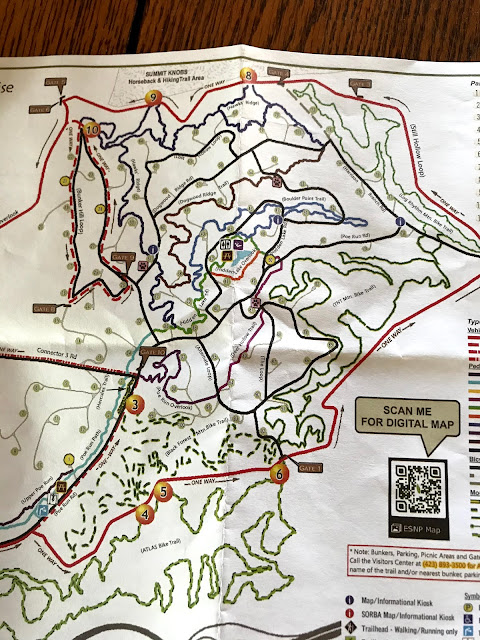You all remember about those bunkers, right?
Here is a typical bunker, built on a fairly level spot in the woods, a concrete structure with a mound of dirt covering, a vent in the top, and trees growing on it. Even though this bunker is easy to spot from ground level, think how hard to find from above in a plane. The wooded area, green in the summer and brown in the winter, would appear a solid parcel of land to a pilot or bombardier. Widely separated in the woods, these bunkers would present a formidable wartime challenge to any enemy bomber.
When we last left reporting our quest to photograph all 100 of the storage bunkers in the Enterprise Park, the count of completed tasks had reached 89. Only 11 more to go.
The last remaining bunkers were situated on interior roads that were marked closed and prohibited to travel by unauthorized cars or pedestrians.
I politely asked a ranger one day if I could go into that area, and he told me that permission would have to be granted by the proper person in charge. He also said that he was not that person, and, with the visitor center closed because of covid, he did not know exactly who to ask.
One rainy afternoon, I decided any staff in the Park would not be very busy, I motored in and started looking. Coming upon a ranger vehicle sitting on a side road, I stopped and pulled my car in beside his so our driver's side windows would be close so as not to let too much rain into the cars. As I explained my quest, and the fact that there were only 11 more to be "documented", which to me sounded important, he got on his phone and found a person working in the visitor center.
Okay, here came the answer back: I should come back any day the park was open, between the hours of 7:00AM and 3:00PM, find a ranger on duty, and tell him to check for me if indeed it was a good day.
The very next day, striking while the iron was still hot, I rolled into the Park. Not finding an authoritative person near the entrance, I moved toward the interior. Realizing that the road I needed to enter, sported a small sign indicating a Ranger station lay beyond the entrance, I turned onto the closed road, found a maintenance facility, and a parked ranger vehicle nearby, so I parked to look around.
Walking into the maintenance barn, and finding no one, I noticed a light from a side door. Looking through the door window, I saw a hallway with various office doors. Pushing my way into the area, and moving down the hall toward an open door, I met a man coming toward me. He introduced himself, as James Breedwell, Director of Maintenance and asked me my business. After hearing my situation, he said sure, it was possible, and I could park there and walk at my leisure to find the 11 sites.
Since this area is off limits to park visitors, the bunkers were not kept up as visitor sites, but only used for maintenance and storage.
After I had found all the bunkers in this restricted area, I found that I had not only completed my self-imposed task, I had also knocked down all the spider webs that filled the roadways and paths around the bunkers.
As it nearly always happens, at the end of a project, I was left with questions:
1. My last bunker photographed was No. 15, the last stop on one closed road. It sported a solar panel on the roof. What was it used for?
2. One of the Park employees asked if I knew about the bunker that sits in a mass of kudzu on the road leading out of the park area toward I-75. That was news to me, but I did spot it from the road. Now to find some more information on that one. Was it part of the first 100 bunkers built, with the second 100 being those inside the Park?
3. Was this turkey, with three friends, looking for bunkers also?
I'll be sure to fill you in on the answers, and any other worthwhile news I find while out roaming around.





















